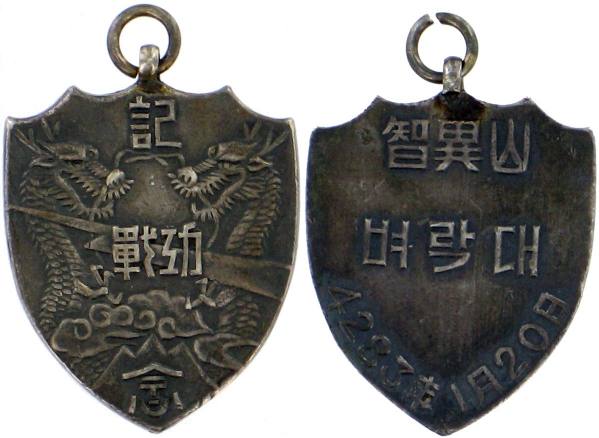Anti-Guerrilla Warfare Service Medal 공비토벌기장 (共匪討伐記章)

During the late 1940s and early 50s, the Communists had a major political advantage in the South of Korea. During World War II, the Nationalist Korean Government in Exile, had aligned itself with Nationalist Chinese, while the Korean Communists aligned themselves with the Russian and Chinese Communists. Most Koreans understood it was the Chinese Communists, and not the Chinese Nationalists, who had actively fought against the Japanese. In addition, during the Japanese Colonial Period, any patriotic Korean, who was arrested, was imprisoned as a “Communist” regardless of that person’s political affiliation. In 1945, thousands of these so-called communists were released from the Japanese political prisons. To many Koreans, it appeared that the Communists were the real saviors of the country. The U.S. Army Military Government in Korea (USAMGIK 미군정, 美軍政), made the situation even worse. They did not allow the Korean Nationalist Army, which had been attached to China’s Generalissimo Chang Kai Shek’s army, to return to Korea as a Victorious Army. It was instructed to disarm and return to Korea in any manner that they could find. In addition, many of the Korean officers in the South’s defense forces, were originally commissioned officers in the Japanese Army during WWII, and were considered by many to have been Japanese collaborators.
The first constabulary regiment was established in Seoul during January 1946, with another eight regiments being formed by November. Soon afterwards, all private military organizations were disbanded. No tests of recruits were permitted except physical examinations. Barracks quickly became places for ideological feuding, and terrorism between leftists and rightists became commonplace. Two years later, a Constabulary unit on Cheju Island rebelled against the central government. The 14th Constabulary Regiment was ordered to suppress the communist insurrection, but revolted and occupied two cities in South Cholla Province. The 4th Regiment, dispatched to regain control, also joined the rebellion. The revolt spread to the Constabulary Regiment stationed in Taegu. Although all the towns were recaptured by loyal troops within a week, several hundred rebel troops escaped to the almost impenetrable Chiri Mountain area and used guerrilla tactics to harass the new government. Open revolts, such as this, prompted civilian communists to assist the guerrilla forces. Many rural areas ruled by the government during the day were ruled by guerrillas at night. The constabulary was subsequently purged of over 1,300 subversives. Then the ROK leaders abolished the 14th Regiment for its shameful conduct and burned its colors. All units bearing the number 4, either, alone or in combination, were re-designated and the use of the number was henceforth abandoned. (It must also be pointed out that in Korean, Chinese and Japanese, the word ‘Four’ is a homophone for the word ‘Death’.)
In a six-month period from July to December 1949, the Korean army mounted 542 separate counter-guerrilla actions, nearly three operations a day. After the Inchon landing, thousands of North Korean troops turned to guerrilla actions, especially in the area around Chiri San. On Apr. 15, 1949, the National Korean Police Bureau established a Special Police Force specifically for the Chiri Mountains. In November 1950, the UN Command reported; “The scope and effectiveness of guerrilla activities kept approximately 30 percent of the total UN troop strength in Korea engaged in anti-guerrilla operations, diverting combat units from front-line duty and precluding formation of adequate reserve.” The following month, Police Combat Commands were established in the Taebaik and Chiri Mountain Areas. Another Police Combat Command was established in April 1953 for the Southwest Area of Korea. The Southwestern Combat command was disbanded in June 1955, almost two full years after the end of the Korean War. It wasn’t until May 9, 1957, that the Korean government was finally able to clear the Chiri Mountain area.
The Anti-Guerrilla Warfare Service Medal was created by Presidential Decree #488 on April 28, 1951 and was awarded to the military, civilians attached to the military, police officers, civil servants, railroad workers engaged in military transportation, postal employees who were engaged in military communication and to persons who engaged in giving aid to those killed or injured by the guerrillas. Temporary employees and Sailors could receive the medal only if they were engaged in military affairs with an exceptional achievement. The Ministry of National Defense was responsible for the enforcement and awarding of the medal. The legislation requires that each awarded medal be accompanied by an award document. One problem with the original legislation was that it neglected to include the general public in its list of possible award recipients. When fighting guerrilla insurgents, the support of the public is vitally important. This oversight was corrected on Jan. 11, 1952 under Presidential Decree 595. It was also at this time that awards to the police officers, civil servants and the public became the responsibility of the Ministry of Home Affairs. I have not found any legislation which ended this medal.

Obverse:
記念 Commemoration (Top and bottom characters)
戰功 Military Merit (Across center)
Reverse:
智異山 Chiri Mountain
벼락대 Lightning Company
4283年 1月 20日 (Jan. 20, 1950)
